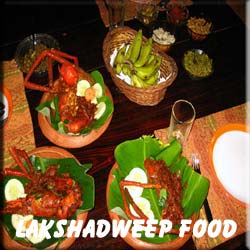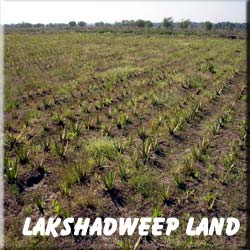CULTURE IS THE ART OF LIVING
Today the population of Lakshadweep is mostly dominated by the Muslim community but still this Union territory was initially rich of various ethnic groups with centuries old traditions and culture. Though the union territory does not have any aboriginal group but still number of scholars believe that the original habitants of the land of Lakshadweep were the Aminidivi community. There are evidences from the archeological department which states that the existence of human settlement in the region was around 1500 BC.In 1498 the Portuguese came to this island and they ruled till 1545 which was further taken over by the Muslim house of Arakkal, followed by Tipu Sultan. After the death of Tipu Sultan the island came into the hands of the British and soon it was formed into a union territory in 1956.Though the majority of the population are Muslims, they are all ethnically influenced by the Malayalis because Kerala is their neighboring state. The people of Lakshadweep mostly speak Malayalam and the Mahi language.
The culture of Lakshadweep can be best expressed as comprising the following : ORIGIN AND ETHINICITY
The people of Lakshadweep are categorized based on their social status and occupation. The past history of this union territory shows evidences of a wide variety of tribal communities which involves ethnic groups like Aminidivi, Koyas, Malmis and Malcheris. The distinct feature of the ethnicity of Lakshadweep lies in its multi-dimensional cultural ecstasy which in turn glorifies the bliss of the only religion namely Islam. It is believed that Ubaidullah, a great Muslim prophet who once visited the island did lot of sermons which inspired many people of the island who started following Islam. But however the ethnicity of this island is divided into four groups namely the Aminidivis who are supposed to be the first and original habitants of Lakshadweep and they live in the island of Amini.Islam is the major religion followed by the Aminidivis and also influences their socio-cultural dimension. The next are the people belonging to the Koyas community who are supposed to have prestigious or the highest position in the social structure of Lakshadweep. The Koyas are the land owners and also have a stronghold in the local panchayats who predicts the ultimate verdicts in any case of disputes. The Koyas though hold a high position in the society still have to earn their living by ferrying indigenous boats which is one of the main occupations. The Koyas form an integral part of the Lakshadweep communities enriching the ancient civilization of the island. Next comes the Malmi community who are predominantly sailors and they work under the superior Koyas. The Malmis are also known for the operation of the nautical tables and texts. CULTURE
Though the islands of Lakshadweep is small in terms of area, still when it comes to its lifestyle and rich cultural heritage the island stands apart in its diversity. This diverse and multifaceted culture makes us bewildered and astonishes us gasping for more. Though Islam is the dominant religion followed in Lakshadweep, other religions are also prevalent here. The culture of Lakshadweep is highly influenced by the neighboring state Kerala therefore these two places are unmistakably similar to each other. Lakshadweep being home to major tribal communities, the people lead a simple lifestyle and is acknowledged for their unique rituals and celebrations. The main working community of Lakshadweep is the Melacheris while the Koyas belong to the superior land owners. The Malmis are meant to be the sailor community. It can be said that Lakshadweep people are a true manifestation of cultural unification and social enrichment. The most commonly spoken language by the people of Lakshadweep is Malayalam.The culture of the people of Lakshadweep has got a historical link with the state of Kerala when it comes to it music and dance. Also the music and dance of the people of this island can be seen to be highly influenced by Islamic culture. Any social or religious festival is accompanied by the tribal music and colorful tribal dances. There are folk songs for every special occasion like marriage, birth, ear boring, death, etc. CUSTOMS AND TRADITIONS
According to the custom of the people of Lakshadweep when a child is born, it is named on the same or on the third day and the head of the baby is shaved on the 40th day after which a feast is arranged and offerings are made at important mosque. In case of boys a custom called Markakalyanag or more commonly known as circumcision takes place between 6 to12 years and the barber does the circumcision. For girls at the age of 1 to 2, ear boring is done. At the time of child birth, the father sends a small bed and a dress for the baby and once the baby is born, beaten rice and coconuts are sent to the houses of all relatives. Marriages are allowed only within the same caste or community like a higher caste male can marry a woman of higher caste. The husband is obliged to make an annual payment towards the upkeep of his wife which is part of the marriage settlement and contract. There is no social stigma to divorce nor is it a disqualification for a woman to seek fresh alliance. A wife can demand divorce on grounds of non-payment of customary due and adultery. COSTUMES
The men of this island mainly wear a coloured or a white dhoti around their waist and it goes up to their knees. They also tie a silver thread around their hip which mainly acts as a girdle to keep the dhotis firm around their waist. In some cases the women folk also tie this silver thread around their waist. The men mostly leave their upper part of the body bare but of late they have started wearing banyans and in cases of occasions they adorn themselves with cotton or silk drapery, invested with impressive embroidery. The elders use a turban as their headgear. The women of Lakshadweep wear a Libu or a long gown which runs from shoulders to ankles. The women also have a headgear commonly known as Phatugan. However the traditional attire of the women comprises of Kachi which envelopes from the waist and tucked into the waistband of silver thread. It is topped off by a full-sleeves close-fitting jacket around the waist. The main ornaments which are used by the women of Lakshadweep are a waist-ornament called Aranchan, bangles called Vala or Kodakam, for the wrists, ear-rings, Koodu and Alikkath, and a necklace, Urukku, are the popular jewellery items. ARTS AND CRAFTS
Lakshadweep emerging as a center for tourism is also getting famous across the country for its handicrafts items which are made of shells, coir and oysters. Corals, shells and oyster are widely used in jewellery and decorative items. The shells of the tortoise and coconut are used in the manufacture of walking sticks of various shapes and sizes. CUISINE

Being visited by lot of tourists the people are also used to other food items like Continental, Chinese, Thai and Korean. However any dish prepared by the people of Lakshadweep will have lot of coconut added to it.
OCCUPATION

FAMOUS PERSONALITIES
Prahlad Kakkar -Indian ad film director, best known for his work on the famous Pepsi TV commercial with Amitabh Bachchan and Sachin Tendulkar.


